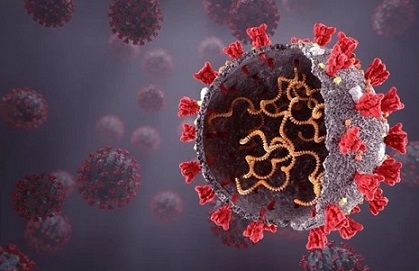Unveiling The Viral Hijack: How SARS-CoV-2 Targets Immune Cell Proteins For Evasion
Nikhil Prasad Fact checked by:Thailand Medical News Team May 17, 2024 1 year, 7 months, 2 weeks, 5 days, 5 hours, 4 minutes ago
COVID-19 News: PDZ (PSD-95/Dlg/ZO-1) domain-containing proteins are a diverse and essential family of scaffolding proteins involved in numerous cellular processes. These proteins are predominantly known for their roles in maintaining cell polarity, but they also participate in signaling pathways, cytoskeletal organization, and cellular junctions. A PDZ domain is a protein-interaction module typically composed of around 100 amino acids. This domain forms a hydrophobic pocket capable of binding short linear motifs (SLiMs) at the C-terminal region of protein ligands, known as PDZ-binding motifs (PDZbms). These motifs are classified into three types based on their terminal amino acid sequences: Type I (X-S/T-X-Φ-COOH), Type II (X-Φ-X-Φ), and Type III (X-D/E-X-Φ), where X is any amino acid and Φ is a hydrophobic amino acid.
 Unveiling The Viral Hijack: How SARS-CoV-2 Targets Immune
Unveiling The Viral Hijack: How SARS-CoV-2 Targets Immune
Cell Proteins For Evasion
Viral Hijacking of PDZ Proteins
Viruses have evolved mechanisms to exploit host cellular machinery to facilitate their replication and dissemination. One such mechanism involves the hijacking of host PDZ proteins. Viral proteins often mimic host PDZbms, thereby interfering with the host’s endogenous PDZ-dependent interactions. This interference can favor viral propagation and increase virulence.
The envelope (E) protein of SARS-CoV-2 contains a PDZbm in its C-terminal sequence (DLLV), which is classified as a Type II PDZbm. This motif has been identified as a virulence determinant, meaning its interaction with host PDZ proteins plays a crucial role in the pathogenicity of SARS-CoV-2. Identifying these interactions and understanding their implications is critical for developing therapeutic strategies against COVID-19.
Studying PDZ-PDZbm Interactions
In previous studies, several PDZ proteins targeted by the SARS-CoV-2 E protein (2E) have been identified in human monocytes. In a new study by researchers from Instituto Nacional de Enfermedades Respiratorias Ismael Cosío Villegas-Mexico and Universidad Autónoma Metropolitana-Iztapalapa-Mexico that is covered in this
COVID-19 News report, docking and molecular dynamics analyses were employed to identify the most favorable PDZ-PDZbm interactions among seven host PDZ proteins and the PDZbm of 2E.
Additionally, changes in the expression of three identified PDZ proteins (syntenin, ZO-2, and IL-16) in human monocyte-derived macrophages (MΦ) and dendritic cells (DCs) were analyzed upon stimulation.
PDZ Proteins in Innate Immune Cells
PDZ proteins play crucial roles in various cellular processes within innate immune cells, although these roles are not yet fully understood. The identification of PDZ proteins targeted by viruses in immune cells is not only relevant for understanding host-virus interactions but also provides insights into the functions of these proteins in immune responses.
Key Findings<
/strong>
-Docking and Molecular Dynamics Analyses
Molecular dynamics simulations revealed specific interactions between the 2E PDZbm and several host PDZ proteins. For instance, ZO-2 contains three PDZ domains, but only PDZ1 and PDZ3 were likely to bind to 2E, with PDZ1 showing the best fit. These interactions were primarily stabilized by hydrogen bonds and electrostatic interactions.
-Syntenin
Syntenin, which contains two PDZ domains, is a key regulator of membrane dynamics and has been co-opted by various viruses, including SARS-CoV-2. In this study, the 2E PDZbm preferentially bound to the PDZ2 domain of syntenin. This interaction may contribute to the excessive inflammatory cytokine production observed in COVID-19, suggesting that targeting this interaction could help reduce inflammation.
-ZO-2 and IL-16 Expression
ZO-2 and syntenin showed increased expression in DCs upon maturation with LPS, MC, or Poly I:C, indicating their potential roles in DC functions. For IL-16, differential subcellular localization was observed, with a shift towards the plasma membrane in mature DCs, suggesting a role in stabilizing MHC-II at the cell surface.
Implications for Immune Response
The differential expression and localization of PDZ proteins in immune cells upon activation suggest that these proteins have significant roles in antigen presentation and immune response. The targeting of these PDZ proteins by SARS-CoV-2 may constitute a viral evasion mechanism, impairing immune cell functions.
Therapeutic Potential
Understanding PDZ-PDZbm interactions opens up new avenues for therapeutic interventions. Designing inhibitors that mimic the PDZbm of viral proteins could potentially block these interactions, providing a strategy to combat viral infections and related immune disorders. For instance, inhibitors targeting the PDZ-dependent interaction of MPP1 with the ABCC4 transporter have shown promise in increasing chemotherapy susceptibility in acute myeloid leukemia (AML) cells.
Future Directions
-Experimental Confirmation: Further in vivo studies are required to confirm the PDZ-dependent interactions identified through molecular dynamics simulations.
-Functional Analysis: Detailed functional analyses of PDZ proteins in immune cells will help elucidate their roles in immune responses and viral pathogenesis.
-Therapeutic Development: Continued efforts in designing PDZbm-based inhibitors and small molecules targeting these interactions could provide new treatments for viral infections and immune-related diseases.
By exploring the complex interplay between viral proteins and host PDZ proteins, we can gain deeper insights into the mechanisms of viral infection and immune regulation, paving the way for innovative therapeutic approaches.
Conclusion
This study highlights the importance of PDZ proteins in the context of viral infections and immune responses. The interactions between the SARS-CoV-2 E protein and host PDZ proteins in immune cells suggest that these interactions play critical roles in viral pathogenesis and immune evasion. Further research is needed to fully understand these interactions and their implications, which could lead to the development of novel therapeutic strategies for COVID-19 and other diseases involving PDZ-dependent interactions.
The study findings were published in the peer reviewed journal: The Journal of Leukocyte Biology.
https://academic.oup.com/jleukbio/advance-article/doi/10.1093/jleuko/qiae118/7674340
For the latest COVID-19 News, keep on logging to Thailand Medical News.
